Menu
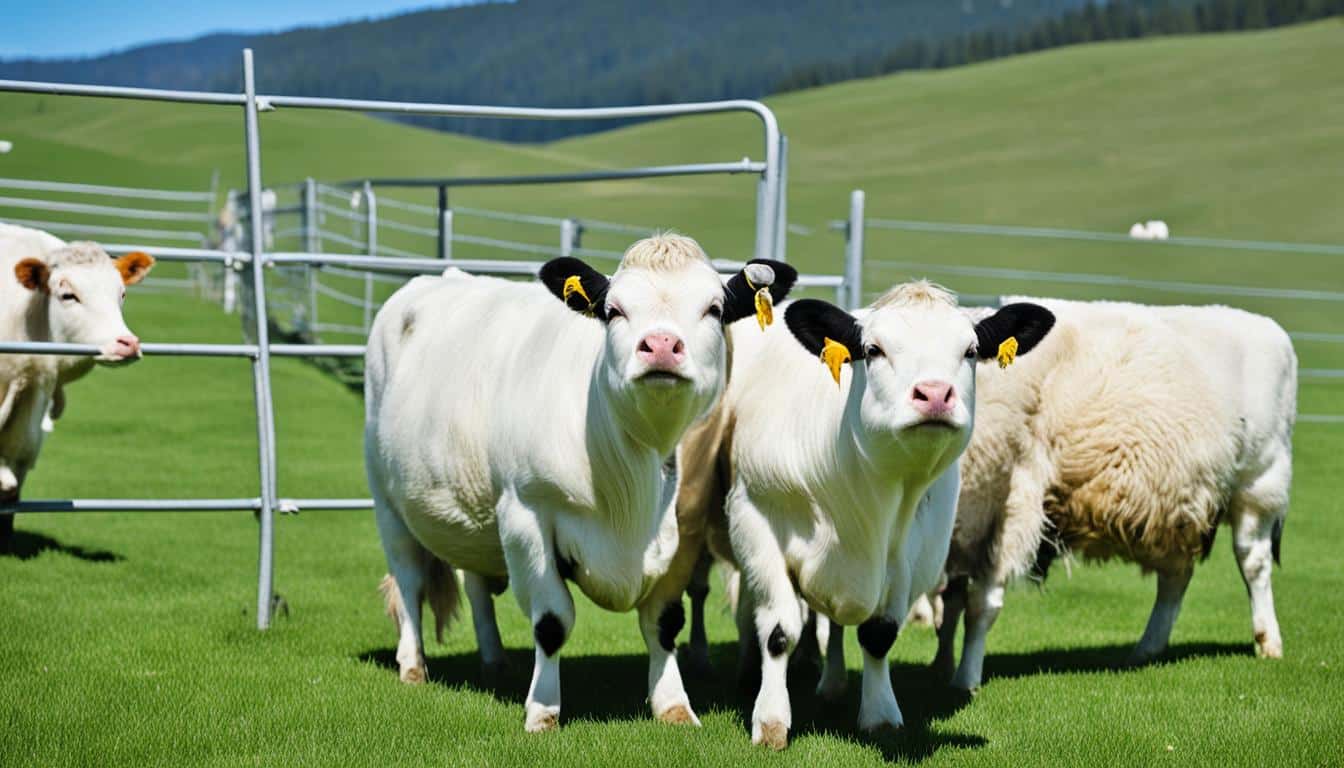
Did you know that putting too many animals together can make sickness and injuries more likely? By managing how many animals are kept in one place and making sure they eat right, we can lower these dangers. Preventing diseases in our animals is key to keeping our herds healthy and our farms running well.
Farm animals face many health risks from germs like bacteria, viruses, and parasites. These sicknesses can cost a farm a lot of money. It’s much better to stop diseases from happening than to treat them later. With early actions, we can keep our animals away from common diseases and protect our farm’s income.
Animal diseases hurt livestock and can cause death. It’s vital to have good disease prevention strategies. These help keep the production of livestock steady. Preventing diseases means more food, babies, and products like milk and eggs.
Oklahoma’s livestock business shows why keeping diseases away is key. It includes big and small farmers and animal keepers. Yet, diseases cost a lot, lower food use, and hurt output.
Diseases from bacteria, viruses, and more are big problems. They move through dirty stuff, water, and air. To fight this, using sophisticated disease prevention strategies is crucial. This includes fewer farm guests, clean spaces, and often cleaning tools.
These steps save money and protect jobs and health. Remember, some diseases can jump from animals to people. So, complete rules on who enters farms are a must.
Keeping farms clean is very important. Things like talking to vets and choosing healthy animals matter. So does having animals of similar age away from each other and getting vaccines on time.
It’s key to have plans that suit each farm’s needs. This way, we look after our animals and the communities that depend on them.
Setting up strong biosecurity on farms is vital to stop diseases from spreading. Farmers need to make detailed plans. These plans should cover steps to keep the farm safe and the animals healthy. They must use many methods to prevent diseases.
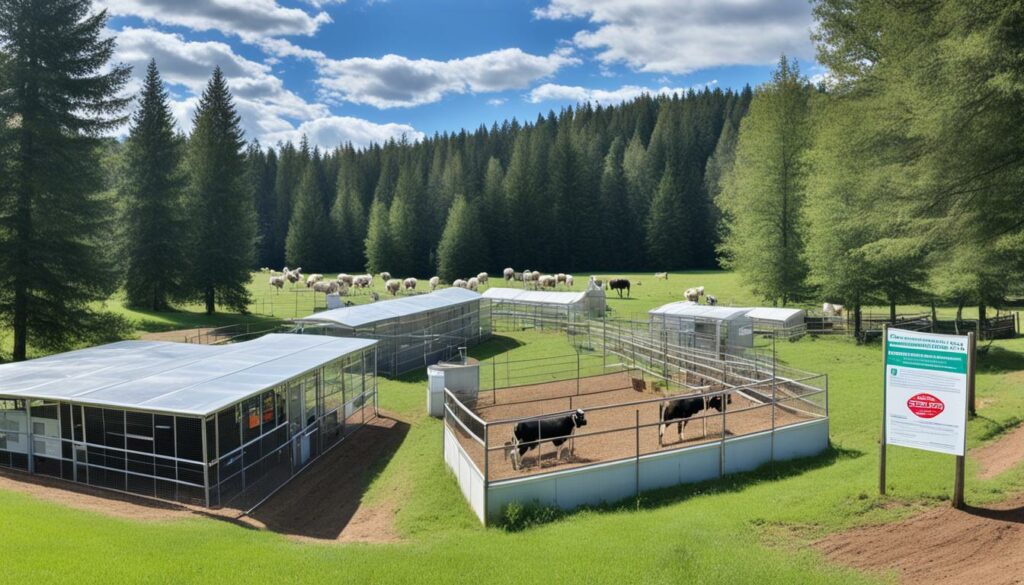
Creating a detailed biosecurity plan is key for fighting diseases. This means keeping close track of each animal. Also, know everywhere they go to stop diseases from spreading. When new animals come, keep them apart for 21-30 days to make sure they don’t bring in sickness.
Farmers should keep an eye on their animals’ health all the time. They should keep records of any treatments. If an animal seems sick, they need to act fast to avoid a big problem. They should also avoid sharing vehicles and tools as they can carry diseases.
Getting semen for breeding from trusted sources is important. This way, the animals born will be healthy. If an animal starts to look sick, quick checks and care can help stop disease spread.
Cleanliness on the farm is crucial for biosecurity. Keeping water areas clean and changing hay regularly is important. Only buy feed from places with good quality control to keep diseases out.
Tools used in different parts of the farm must always be clean. This keeps diseases off the farm. No matter what, ensuring dead animal bodies are dealt with safely is essential. This keeps away wild animals that could bring diseases.
The practice of biosecurity is backed by studies from Switzerland, Spain, and Finland. Farms that follow strict biosecurity often see better farm health and more productivity. This proves how vital these steps are.
| Biosecurity Measure | Importance |
|---|---|
| Isolation of new animals (21-30 days) | Reduces disease transmission |
| Recording animal movements | Tracks disease spread |
| Clean and disinfect shared equipment | Prevents pathogen spread |
| Regularly clean waterers | Maintains health and hygiene |
| Purchase feed from reliable sources | Ensures quality and safety |
It’s essential to know about common livestock diseases for animal health. This includes diseases like foot-and-mouth disease that can wipe out whole herds. This disease is particularly bad for milk farms according to Lyons et al. (2015).
Livestock diseases and droughts cost farmers a lot worldwide. Ahmed et al. (2019) showed how big the impact is in Northern Tanzania. Different diseases need different ways to control them. So, it’s crucial to have smart strategies to prevent these diseases.
Injuries and diseases from production also need our attention. Charfeddine and Pérez-Cabal (2017) found that claw disorders in cows really hit dairy farms hard. They affect milk, baby cows, and how long the cows can keep working.
Lots of issues affect how healthy livestock are, as Adams et al. (2017) show in the US. Things like lame cows and sores on their legs can make them very sick. How we care for and house the animals makes a big difference. Good care means fewer sick animals.
To sum up, we must learn about different kinds of livestock diseases. They include big ones, small ones, infectious, and non-infectious. Knowing these helps everyone in farming. It means they can be more productive and handle financial troubles better.
| Research Study | Focus | Findings |
|---|---|---|
| Ahmed et al., 2019 | Economic burden in Tanzania | Significant impact of livestock disease and drought |
| Adams et al., 2017 | Prevalence of lameness and lesions | Associations with housing and management practices |
| Charfeddine & Pérez-Cabal, 2017 | Claw disorders in Spanish Holstein cows | Impact on milk production, fertility, and longevity |
| Lyons et al., 2015 | Foot-and-mouth disease in Kenya | Reduction in milk production |
| Reagan, 2020 | Production losses in Kenya | Quantifying the impact of foot-and-mouth disease |
| Limon et al., 2020 | Lumpy skin disease in Nigeria | Economic impact on subsistence farmers |
Farm diseases are closely connected to what animals eat. Good nutrition keeps animals healthy and improves their ability to fight off sickness.
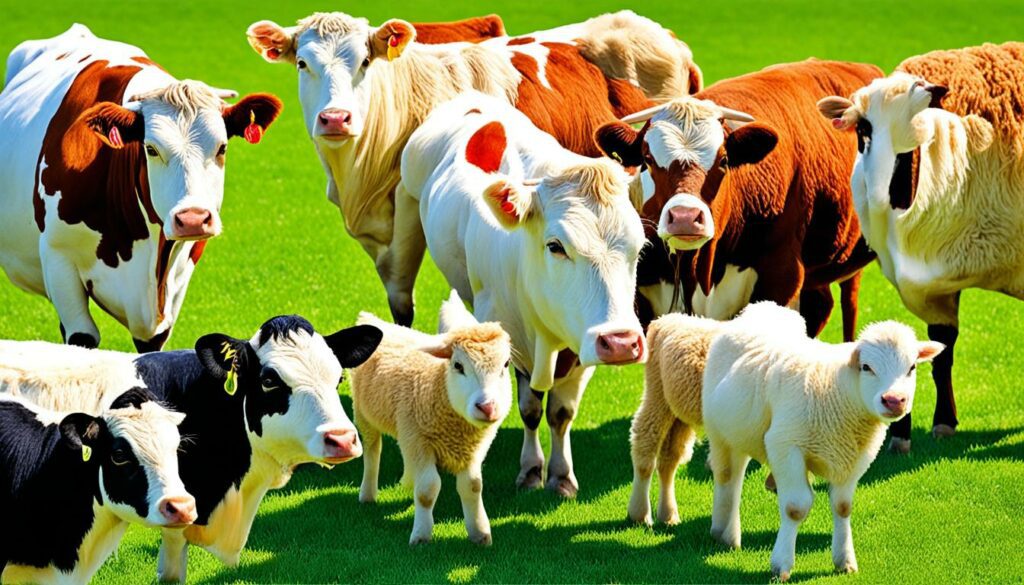
Choosing the right feed is key. It’s vital to pick a trusted supplier who follows strict rules. The National Academies offer advice on what nutrients animals need. Using nutrient-rich feeds can boost animal health and their disease resistance.
Keeping an eye on what animals eat is important. This includes checking the quality and quantity of their food. It helps make sure they get a balanced diet. This prevents immune system problems before they start.
Researchers found that diet types, like low-carb or low-fat, affect health differently. So, matching nutrition to an animal’s needs is crucial for its well-being. Watching what animals eat closely is central to keeping farm diseases under control.
What animals eat can interact with their genes in surprising ways. A balanced diet is critical. Plant-based feeds, for instance, are rich in antioxidants and fibre. These help animals fend off diseases better.
The livestock industry in Oklahoma is key for the state’s economy. It includes large-scale meat or milk farms, purebred breeders, and smaller farms. To protect these businesses, it’s key to control the number of animals kept in one place. If too many animals are kept together, it can bring many problems. These include a higher chance of diseases spreading and more injuries. Giving enough space for animals can cut down the risk of infections. This makes for a healthier and more successful farm.
Putting too many animals in one place makes them stressed. It also makes them weaker against illnesses. This is because they can’t cope with things like cold, poor air, and not enough food or water. Dangerous germs and parasites thrive in these stressful environments. They can cause a lot of harm, including death. This raises the costs of treating the animals and slows down their growth.
Keeping the right number of animals in a space is part of good farm management. This helps keep the animals happy and healthy. It also makes the farm more environmentally friendly. For instance, having enough room for each animal makes it harder for diseases to spread. This includes diseases passed by touching or by dirty water and feed.
Research shows that diseases like to spread through herds in certain ways. This can happen by sick animals, their carriers, and even from insects or birds. By making sure animals have enough space and life is clean, the farm is healthier. Proper space management also means using resources better. This can make the animals grow faster and be more productive.
| Factor | Impact of Animal Overcrowding | Benefit of Proper Animal Density |
|---|---|---|
| Stress Levels | Increased | Reduced |
| Risk of Infections | High | Low |
| Animal Welfare | Poor | Enhanced |
| Feed Conversion | Inefficient | Efficient |
By carefully managing how many animals live together, farms stay healthy. It’s important to work closely with a vet and keep the farm very clean. Doing this doesn’t just prevent overcrowding and its problems. It also leads to healthier, more productive animals. This helps farmers in the long run, supporting their business and the economy.
Vaccination is vital for keeping animals healthy, preventing deadly diseases for over 100 years. A good livestock vaccination schedule protects animal health, cuts the risk of diseases spreading, and keeps farms productive.
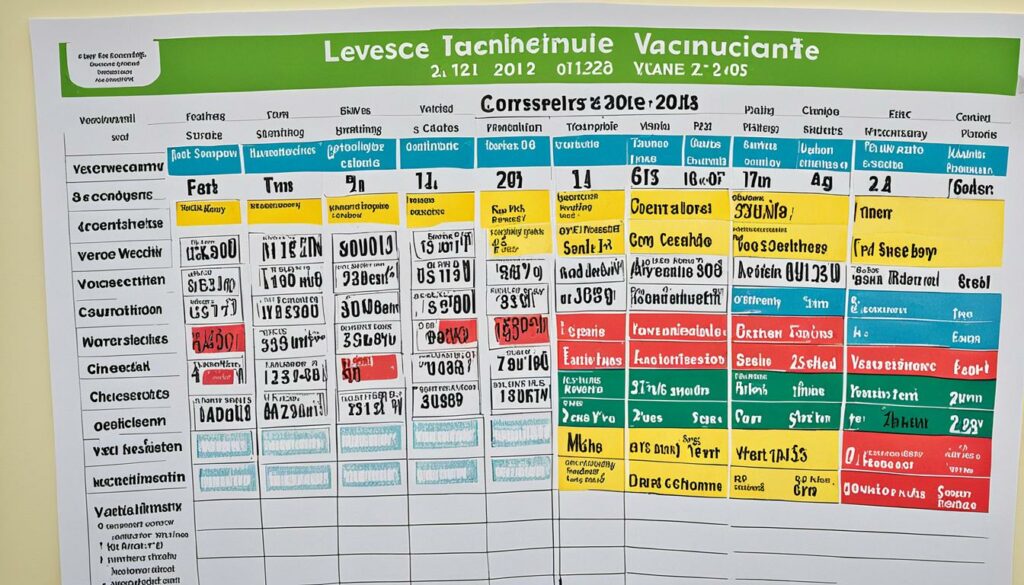
It’s key to know the types of vaccines and what each does. There are live, attenuated, and inactivated (killed) vaccines. Live ones can give stronger, longer protection but need careful handling. Inactivated vaccines are safer for weak animals. Both types work well in a vaccination plan.
Vaccinations work best when given on time, perfect for young animals whose defence systems are still growing. These animals need several shots first. After that, boosters every few years keep their immunity strong.
Keeping vaccines effective requires correct handling and storage. They must be cold, usually between 2°C and 8°C, until used. And they should not be used after they expire. Bad handling or storage makes vaccines less effective, risking animal health.
Reports show that strict vaccination rules have massively helped pet and farm animal health. By sticking to the right vaccine storage and handling, the benefits of vaccines are better. This keeps animals safer.
So, making a good livestock vaccination plan and following storage rules boosts animal health and farm output. As we get better at this, farming improves, making it safer and more efficient.
Clean and dry housing is vital in stopping livestock diseases and keeping the farm clean. Animals need dry places as too much moisture can hold bacteria. This can make them sick. It’s important to clean often and keep their bedding dry. This also saves the animals’ energy and reduces diseases.
Having good ventilation in livestock housing is key. It keeps the air fresh and stops breathing problems caused by bad smells. A well-ventilated area prevents harmful gases from building up. This lowers the chance of animals getting sick. Also, making sure the housing isn’t too hot or cold helps animals stay healthy.
Animals should have enough space to move freely. Overcrowding raises stress and disease risks. Creating areas for sick animals stops illnesses from spreading among the group.
Farmers should have a checklist for their housing. It should cover cleanliness, ventilation, and space. Following this list makes sure no important areas are forgotten. It keeps the animals healthy and boosts farm productivity.
Keeping a healthy herd relies on strict quarantine and disease testing. By following set biosecurity protocols, we can keep diseases at bay.
Testing early and often is crucial for a disease-free herd. By testing livestock regularly, we can catch harmful bugs before they spread. This keen approach prevents diseases from becoming a bigger problem, keeping our animals safe.
Animals bought new or ones back from public events need special attention. They’re put in isolation for 21 to 30 days, sometimes more, based on health risks.
It’s best to have separate areas for isolating animals with at least 6 feet between. This helps stop diseases spreading. We also use separate tools and gear in each area to stop contamination.
Special clothing and gear are a must for anyone taking care of isolated animals. This prevents sickness from moving to healthy animals in the herd.
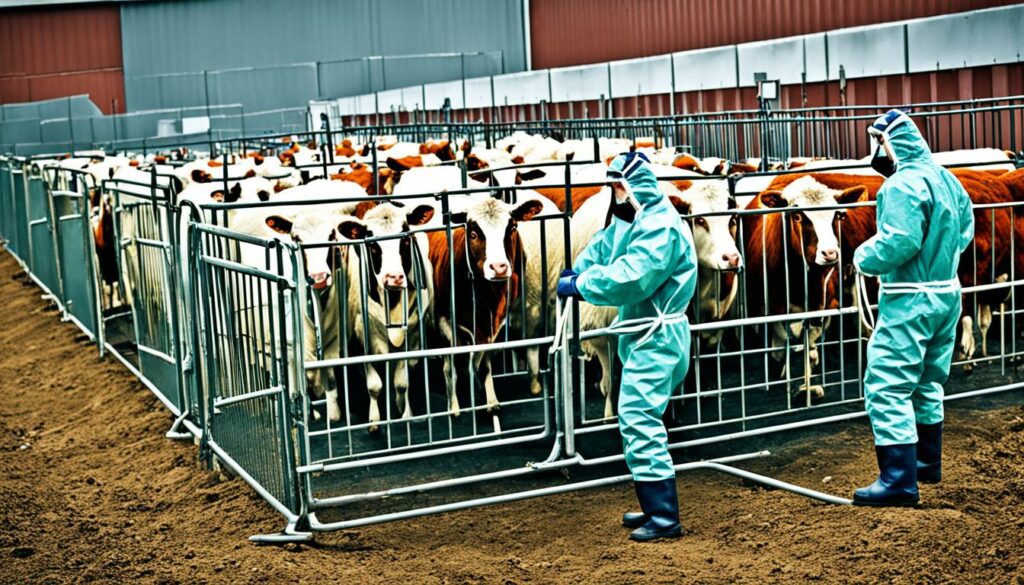
| Practice | Details |
|---|---|
| Separate Areas | Two distinct areas for isolation/quarantine if space allows |
| Buffer Zone | Create a minimum of 6 feet separation from healthy livestock |
| Equipment and Supplies | Do not share between areas; each should have its own set |
| Specific Clothing and Footwear | Separate for each area to prevent contamination |
| Designated Caretaker | One person to handle quarantine animals exclusively |
| Observation | Daily checks for signs of illness, with more frequent observation as needed |
Quarantined animals must be milked after all other milking is done, and the area must be cleaned well. This stops infections from spreading through the milk.
When making quarantine checklists, we must ensure sleeping places are clean and sick animals are far from the others. Checking these regularly keeps our health plan strong.
Keeping an eye on disease monitoring is key to keeping animals healthy. By watching them closely, we see early signs of illness. This lets us act fast to prevent problems. Acting early not only saves animals but also stops diseases from spreading.
Spotting livestock diseases early is super important. If we catch diseases when they’re beginning, treating them works better. Farmers need to know what’s normal for their animals. This helps them see if something is wrong straight away.
The range of diseases that can hit animals is vast. Many things can cause diseases, from different living conditions to new hosts. So, we need strong plans to watch out for and deal with these diseases.
Our plans need to always get better and focus on the biggest risks. Using risk assessment helps us make smarter choices and use our resources well. Working together globally makes our disease detection and response much stronger.
Looking out for diseases means we can also track how they spread and if our control methods work. By keeping an eye out, we can be sure diseases are gone. This shows our control efforts are successful and keeps even more animals healthy.
Contact between farm animals and wild ones can lead to the spread of diseases. To protect the health of our livestock, we must manage these interactions. By controlling outside animal contact, we keep our herds healthy and safe.
To lower the risk of wild animal interaction, we need to use smart methods. Secure fences, buffer zones, and scare tactics can help. They make sure our farm animals stay away from potentially infected wild animals.

Studies show that preventing these interactions is vital because disease outbreaks can be very costly. For example, a study in Northern Tanzania found that drought and disease hit hard, affecting farming and poverty (Ahmed et al., 2019). In Europe, research on diseases shared between wildlife and livestock stresses the importance of keeping them apart (Boadella et al., 2011).
| Livestock Disease | Economic Impact | Regional Impact |
|---|---|---|
| Respiratory Disease | Reduced growth and milk production | US (Stanton et al., 2012) |
| Foot-and-mouth Disease | Production losses in large-scale farms | Kenya (Lyons et al., 2015) |
| Lumpy skin disease, Sheeppox, Goatpox | Economic burden on subsistence farmers | Northeast Nigeria (Limon et al., 2020) |
Managing contamination handling from the outside is key to avoid diseases. We disinfect often and make sure things like vehicles don’t bring in germs. We also keep new animals away until we know they are okay.
Staying ahead of contamination risks is crucial for our animals’ health. One example is how European studies show the need for careful steps to stop disease spread between wild and farm animals (Martin et al., 2011).
Accessing professional veterinary services is key to keeping livestock healthy. In the U.S., most veterinarians work in practices, ready to help farmers. They are where farmers can turn for help with their animals.
Vets play a vital role in keeping animals safe from diseases through vaccinations and tests. They also give advice to keep herds healthy and productive. Their work is essential for both treating and preventing illnesses.
Over 100 vets work with the CDC to tackle diseases that can affect animals and people. This highlights how vet services protect both animal and human health. Vets also work with the USDA to make sure the food we eat is safe, showing their wider role in health protection.
In universities, vets teach students to become the next generation of animal health care experts. This includes vets, vet techs, and other medicine professionals. They also support government organisations such as the USDA and EPA, showing their diverse skills.
Vets also help develop animal health systems in war-torn and developing areas. Their efforts are key to rebuilding communities that rely heavily on their animals. This work is crucial in bringing life back to these areas.
It’s essential to note that not all farmers use professional vet services. While 51% turn to informal help, only 33% choose a vet. This shows a need to encourage more farmers to access professional help for better animal health worldwide.
| Aspect | Professional Veterinary Services | Informal Providers |
|---|---|---|
| Usage by Farmers | 33% | 51% |
| Comprehensive Health Management | Provided | Partially Provided |
| Access to Specialist Knowledge | Yes | No |
Implementing strong farm biosecurity measures is key for animal health protection and farm productivity. We studied 869 papers and picked 14 to explore biosecurity best practices. These practices help stop the spread of diseases.
In six studies, hand washing and sanitisation were shown to be crucial. They play a key role in any good biosecurity plan. Personal protective equipment, highlighted in five studies, is also important. It helps keep animal health safe from harmful bacteria.
From two studies, we learned that vaccination is vital for farm biosecurity by boosting the immune system of farm animals. Intriguingly, four studies discussed using air ventilation flaps. This method helps improve the farm’s environment and fight disease.
In two studies, daily farm tasks were shown to be biosecurity boosters. Different studies suggested that when biosecurity methods are used, risks of disease to humans sometimes go up and sometimes go down. This highlights the need for personalised, ongoing biosecurity planning.
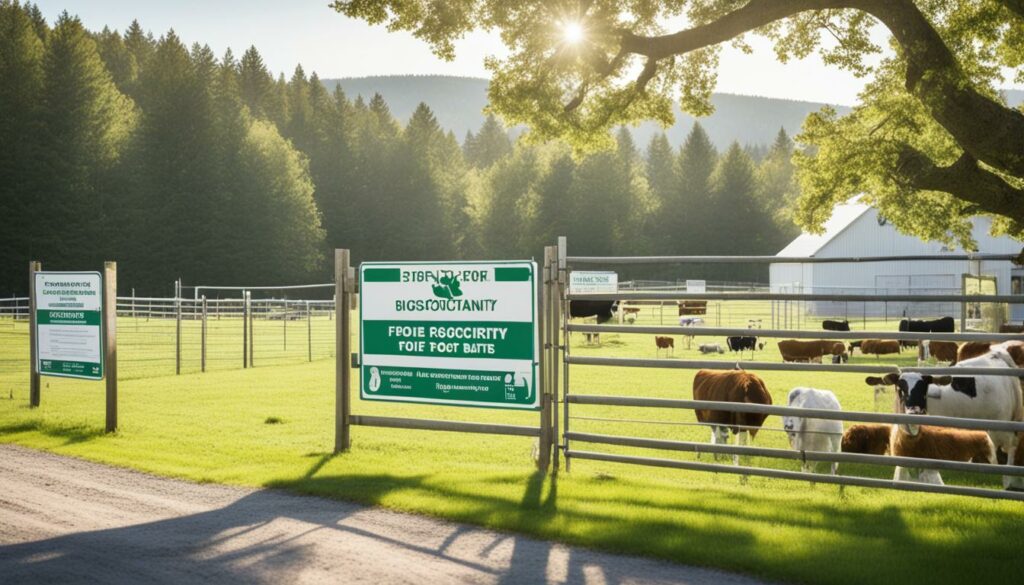
Most research fell under ‘medium risk’ for bias, showing a hopeful but careful view of biosecurity results. Many European studies suggested that biosecurity measures did lower the risk of bacterial diseases in people. But, they also found many uncertainties.
One important study found that less antibiotic use in farm animals decreased antibiotic resistance in both animals and humans. Looking at 181 broiler farms, researchers saw a mix of antibiotic use patterns. This shows how biosecurity and careful use of antibiotics need to work together.
| Biosecurity Category | Number of Studies | Key Findings |
|---|---|---|
| Hand washing, sanitisation | 6 | Essential for reducing pathogen spread |
| Personal protective equipment | 5 | Critical barrier against infections |
| Vaccination | 2 | Proactively improves animal health |
| Other interventions | 4 | Innovative environmental strategies |
| Routine farm activities | 2 | Practical everyday biosecurity measures |
Our study shows using a mix of biosecurity methods is crucial for animal health protection and high farm output. While the methods can be complex, their combined effect is powerful. Farm biosecurity is vital for keeping our farms productive and healthy.
Livestock diseases can lead to big financial losses. These range from less milk to severe impacts on farming during outbreaks. To prevent this, farmers must take steps to keep their animals healthy. This not only helps the animals but also protects the farmers’ future earnings. A good disease prevention plan ensures the animals produce well and food supplies remain stable.

Understanding the real cost of livestock diseases is key. The outbreak of foot-and-mouth disease in the UK in 2001 cost an estimate of US$16 billion. This shows why it’s crucial to have strong prevention plans. In 2017, Colombia faced a similar issue, leading to huge export losses. Such examples point out the urgent need for effective disease control.
Preventing diseases pays off in the long run. A common issue in dairy cows, subclinical ketosis, can lead to costs ranging from 7% to 63%. Livestock diseases and drought in Northern Tanzania can even hit an economic burden of 140% to 151%. To avoid these, farmers should invest in regular health checks, vaccines, and good living conditions. Doing so lowers the risk of big financial hits and helps the animals live longer, producing more.
Here’s a table showing the economic impacts and the ways to prevent some livestock diseases:
| Disease/Event | Economic Impact/Reduction | Preventive Strategies |
|---|---|---|
| Foot-and-Mouth Disease (UK, 2001) | US$16 billion | Vaccination, biosecurity |
| Foot-and-Mouth Disease (Colombia, 2017) | 64% drop in export value | Vaccination, strict quarantine |
| Subclinical Ketosis in Dairy Cows | 7% to 63% | Regular health checks, balanced diet |
| Livestock Disease and Drought (Northern Tanzania) | 140% to 151% | Water management, disease monitoring |
Comparing these cases shows the huge importance of keeping diseases at bay. Investing in prevention leads to stable economic benefits over time in the livestock sector. This helps keep the industry healthy and strong.
It’s crucial to act on preventing diseases in livestock for farming to be sustainable. Diseases in animals not only harm them but also hit the economy hard. For instance, places like Northern Tanzania and Northeast Nigeria have felt this impact. This fits with economic studies in Great Britain, highlighting the big costs of keeping diseases under control. This shows us why we need strong plans to stop diseases from spreading.
Meat and milk demand is set to soar by 2050. This means we have to get better at preventing diseases to keep up. For example, reducing the spread of diseases helps the beef industry in Southern Africa find new buyers. It also means more for small farms in tropical regions. These places need to focus on keeping their animals safe through better living conditions, nutrition, and vaccines. This is vital for global protein supplies.
Illnesses like foot-and-mouth disease can really knock down a farm’s success. Fighting diseases in cows, which cause them to be lame, is another key battle. It shows we must always keep an eye out and manage things well. Looking ahead, we see that how we handle disease prevention is key to farming success. Doing this will help farmers earn more and build a strong future for agriculture.
To stop diseases spreading, keep your animals on a health plan. Feed them properly and keep their homes clean. Also, give them their shots on time.
Preventing diseases means your livestock will be healthier and produce more. This saves you money and keeps your farm running well. It also stops diseases from hurting the public.
Make a strong plan to keep diseases off your farm. Clean often and limit who can come in. This stops germs from spreading.
Diseases like foot-and-mouth spread quickly. To fight them, vaccinate your animals and always keep their spaces clean. Watch closely for any signs of sickness.
Good food helps animals stay well and fight off sickness. Always use trusted food. Also, check often that your animals are eating right.
Too many animals in one place can make them sick or hurt. Giving them space keeps them safer and helps them grow well.
Vaccines stop big diseases and keep your animals healthy. Knowing what vaccines to use and how to store them is very important.
A clean, dry place can stop sickness before it starts. It helps your animals be at their best and most productive.
Testing early and keeping sick animals away stops diseases from spreading. This is a big part of keeping your farm safe.
Keep a close eye on your animals and act fast if you see any signs of sickness. This stops diseases from getting worse.
Wild animals can bring diseases to your farm. Try to keep them away to protect your animals and farm.
Vets are important for checking on diseases, planning vaccines, and giving advice. They help you keep your animals healthy and your farm safe.
Use fences and keep everything clean to block disease germs. This helps keep your animals well and your farm running smoothly.
Not preventing diseases can cost you a lot. But, if you manage disease well, it saves money, keeps food safe, and supports farms. This is good for everyone.